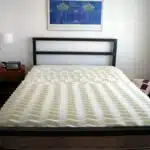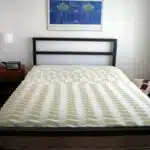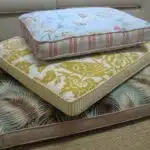As a mattress protector care and cleaning expert, I am often asked about the best ways to maintain the cleanliness of one’s bedding. Many individuals understand the importance of washing their sheets regularly but fail to realize that their mattress protector is just as crucial for a healthy sleeping environment. Proper care of a mattress protector not only ensures its longevity but also improves overall sleep hygiene.
Washing and caring for a mattress protector is relatively simple, yet there are certain steps that must be taken to avoid damage or premature wear. In this article, I will provide insights into how to clean and maintain your mattress protector effectively. Whether you are looking to extend the life of your current bedding or want to invest in a new one, these tips will help ensure that you get the most out of your purchase while maintaining optimal sleep health.
Understanding The Importance Of Mattress Protector Care
Maintaining a clean and healthy sleeping environment is essential for overall well-being. As such, it is crucial to understand the importance of mattress protector care. A mattress protector serves as a barrier between your body and the mattress, preventing dust mites, allergens, and other contaminants from penetrating the surface. By keeping your mattress clean, you can extend its lifespan while also protecting yourself from potential health hazards.
Regular cleaning of your mattress protector provides numerous benefits beyond just cleanliness. Proper maintenance helps to maintain the integrity of the fabric and prevent damage caused by dirt and debris. Additionally, maintaining a clean sleeping area can help reduce allergies and asthma symptoms that can be aggravated by dust mites or other environmental factors.
It is important to note that not all mattress protectors are created equal. Some materials may be better suited for hot sleepers or those with allergies, while others may have specialized features such as waterproofing or cooling properties. Identifying the right mattress protector for you can ensure maximum comfort and protection during sleep.
Identifying The Right Mattress Protector For You
- Mattress protectors come in a variety of materials, from cotton and terry cloth to waterproof fabrics such as vinyl and polyurethane.
- Different mattress protectors offer different features, from dust mite and allergen protection to breathability and waterproofing.
- To ensure the longevity of your mattress protector, it is important to follow the manufacturer’s instructions for washing and care.
- Regularly cleaning and checking for signs of wear and tear can help you extend the life of your mattress protector and keep your mattress in optimal condition.
Types Of Mattress Protectors
As a mattress protector care and cleaning expert, I understand the importance of choosing the right type of protector for your specific needs. When it comes to types of mattress protectors, there are two main categories to consider: waterproof vs. breathable and quilted vs. smooth.
Waterproof mattress protectors are ideal for those who have pets or young children prone to accidents in bed. These protectors will prevent any liquids from seeping through to your mattress and causing damage. On the other hand, breathable protectors allow air to circulate throughout the night, preventing any buildup of heat or sweat. This is especially important for those who live in warmer climates or experience night sweats.
When it comes to quilted vs. smooth mattress protectors, it really depends on personal preference and comfort level. Quilted protectors offer a thicker, more padded feeling while sleeping, which some may find more comfortable. However, smooth protectors tend to be more lightweight and easier to clean.
In summary, when choosing a mattress protector, it’s important to consider both waterproof vs. breathable and quilted vs. smooth options based on your individual needs and preferences. Whether you prioritize protection from spills or comfort while sleeping, there is a protector out there that will suit your needs perfectly without sacrificing quality or durability.
Mattress Protector Features
As a mattress protector care and cleaning expert, I cannot stress enough the importance of selecting the right mattress protector for your specific needs. While waterproof vs. breathable and quilted vs. smooth are two main categories to consider when choosing a mattress protector, there are also several features to keep in mind as well.
When it comes to waterproof vs. breathable features, there are pros and cons to consider for each. Waterproof protectors are ideal for those who have pets or young children prone to accidents in bed, preventing any liquids from seeping through to your mattress and causing damage. However, these types of protectors may not be as breathable as others, leading to an uncomfortable build-up of heat or sweat during warmer seasons or night sweats. On the other hand, breathable protectors allow air to circulate throughout the night, keeping you cool and comfortable while sleeping.
Another important feature is choosing the right size of your mattress protector. It’s crucial to measure your bed beforehand and choose a protector that fits snugly without slipping or bunching up during use. Tips and tricks include measuring all four sides of your mattress for an accurate fit, considering deep-pocketed options if you have a thicker mattress or added pillow-topper, and investing in stretchy materials that can accommodate different bed sizes.
In conclusion, when choosing a mattress protector, it’s important to take into consideration various features such as waterproof vs. breathable options and choosing the right size based on individual needs and preferences. With careful consideration and proper research, finding the perfect mattress protector will ensure both comfort and protection for years to come.
Checking The Manufacturer’s Care Instructions
Having identified the right mattress protector for your needs, it’s essential to understand how to care for it properly. Neglecting to follow care guidelines can lead to damage and a shortened lifespan of your protector. Did you know that 87% of people wash their sheets at least once a week, but only 30% clean their mattress protectors as frequently? Regular cleaning not only extends the life of your protector but also helps maintain its protective properties.
When checking the manufacturer’s care instructions, pay close attention to the recommended washing temperature and drying method. Some protectors are machine-washable, while others require hand-washing or dry cleaning. Using the wrong temperature or drying method can cause shrinkage or damage the waterproof barrier of the protector. It’s also important to avoid using harsh detergents or bleach, which can break down the materials over time.
Preparing your mattress protector for cleaning is crucial in ensuring an effective and thorough wash. Start by removing any visible stains with a gentle cleaner and spot-treatment solution before washing. Then, zip up all zipper closures to prevent snagging or tearing during washing. For optimal results, wash your protector alone or with similar fabrics on a gentle cycle with mild detergent. Following these simple steps will help keep your mattress protector in top condition and ensure a comfortable and healthy sleeping environment for years to come.
Preparing Your Mattress Protector For Cleaning
Before you start washing your mattress protector, there are pre-cleaning steps that you must undertake. Firstly, remove all the bedding from your bed, including the pillows, sheets, and blankets. This will enable you to access the mattress protector easily. Secondly, check the manufacturer’s label for instructions on how to wash and care for your specific type of mattress protector. Different materials require different cleaning methods.
Choosing the right detergent is crucial when washing your mattress protector. You should avoid using bleach or harsh detergents as they can damage the fabric and reduce its lifespan. Instead, opt for a mild liquid detergent that is suitable for delicate fabrics. Additionally, it would be best if you used warm water to wash your mattress protector as hot water can shrink or damage some materials.
After preparing your mattress protector for cleaning and selecting the appropriate detergent, it’s time to start washing it. Make sure to follow the manufacturer’s instructions carefully and use gentle cycles with cold or warm water to avoid damaging the material. Once washed, dry your mattress protector on a low heat setting in a dryer or air-dry it outside in direct sunlight. Sunlight can help kill bacteria and freshen up any odors present on the material.
Moving onto removing stains and odors from your mattress protector without writing ‘step’, one essential tip is to tackle stains immediately before they set in permanently into the fabric. In case of urine stains or odor on your mattress protector, use an enzymatic cleaner that breaks down proteins present in urine or sweat effectively. Avoid using harsh chemicals such as ammonia as they can cause discoloration or damage to some materials like memory foam protectors.
Removing Stains And Odors
Stains and odors on a mattress protector can be unsightly and unpleasant, but they don’t have to be permanent. Fortunately, there are effective cleaning solutions that can help remove these blemishes and restore the fresh, clean appearance of your mattress protector.
To remove stains from your mattress protector, start by identifying the type of stain you’re dealing with. For example, if it’s a protein-based stain like blood or urine, use an enzyme cleaner to break down the proteins. If it’s a grease or oil-based stain like makeup or lotion, use a solvent-based cleaner to dissolve the oils. Always read the manufacturer’s instructions before using any cleaning product to ensure that it’s safe for use on your specific mattress protector.
Odors can also be a problem with mattress protectors over time. To eliminate odors, start by airing out the protector in a well-ventilated area for several hours or overnight. Then sprinkle baking soda over the surface of the protector and let it sit for at least 30 minutes before vacuuming it off. If odors persist after this initial treatment, try washing the protector with an odor-neutralizing laundry detergent or adding white vinegar to the rinse cycle.
With these effective cleaning solutions, you can keep your mattress protector looking and smelling fresh for years to come. In order to maximize their effectiveness, however, it’s important to use the right cleaning products for your specific needs and follow proper care instructions at all times. Let’s now explore how using the right cleaning products can help extend the life of your mattress protector even further.
Using The Right Cleaning Products
When choosing a cleaner for a mattress protector, it is important to consider the materials used to construct the protector and select a product that is suitable. Additionally, it is important to use detergent that is specifically designed for machine washing delicate items, and to avoid using fabric softener as this can damage the fabric. When washing a mattress protector, it is important to use the gentlest cycle available and to follow the instructions provided on the care label. Finally, it is important to allow the protector to air-dry naturally, as this will help maintain its durability.
Choosing The Right Cleaner
When it comes to washing and caring for your mattress protector, choosing the right cleaner is crucial. It’s important to select a cleaner that is effective in removing stains and odors without causing damage to the fabric or compromising its protective properties. However, it’s equally important to consider the impact of harsh chemicals on both your health and the environment.
One way to ensure you’re using an eco-friendly cleaner is by checking the label for ingredients such as phosphates, chlorine bleach, and synthetic fragrances. These chemicals can not only be harmful to your health but also contribute to water pollution. Instead, opt for cleaners made from natural ingredients such as vinegar or baking soda. Not only are they safer for you and the planet, but they’re also highly effective at removing stains and odors.
By understanding the impact of harsh chemicals, you can make informed decisions when selecting a cleaner for your mattress protector. Choosing eco-friendly cleaners not only protects your health but also helps preserve our planet for future generations. So next time you’re shopping for a cleaning product, take a moment to read the label and consider the impact of your choice.
Washing With Appropriate Detergents
When it comes to caring for your mattress protector, using the right cleaning products is essential. Not only do you want to ensure that the product effectively removes stains and odors, but you also want to consider the impact of harsh chemicals on both your health and the environment. In this subtopic, we will discuss washing with appropriate detergents, particularly eco-friendly options.
Eco-friendly detergents are a great option when it comes to washing your mattress protector. These products are made from natural ingredients that are safer for both you and the planet. They don’t contain harsh chemicals such as phosphates, chlorine bleach, or synthetic fragrances that can be harmful to your health and contribute to water pollution. Instead, they use plant-based ingredients like essential oils and non-toxic surfactants that are just as effective at removing stains and odors.
If you prefer DIY stain removal methods when washing your mattress protector, there are many eco-friendly options available as well. For example, using a mixture of baking soda and water can remove tough stains such as blood or urine without causing damage to the fabric or compromising its protective properties. Additionally, white vinegar is an excellent natural cleaner that can remove odors while also disinfecting the fabric. Just remember not to mix these two solutions together, as they can neutralize each other’s cleaning power.
In conclusion, washing with appropriate detergents is crucial when caring for your mattress protector. Eco-friendly detergents and DIY stain removal methods are excellent options for those who want to protect their health and the environment while still effectively cleaning their bedding. By making informed decisions about the products you use, you can ensure that your mattress protector stays in top condition while also contributing to a healthier planet.
Hand Washing Your Mattress Protector
When it comes to maintaining the quality of your mattress protector, hand washing is often a more effective method than machine washing. By hand washing your protector, you have more control over how much pressure you apply and can be sure that every inch of the fabric is properly cleaned. But what are the best techniques for hand washing?
Firstly, it’s important to fill a bathtub or large sink with lukewarm water. Avoid using hot water as this can damage the materials in your mattress protector. Add a small amount of mild detergent to the water and mix it in thoroughly. Gently place your protector into the water and use your hands to agitate it slightly.
Once you feel satisfied that every part of your mattress protector has been cleaned, gently wring out any excess water before laying it flat on a clean towel to dry. Avoid drying it in direct sunlight or using high heat settings on a tumble dryer as this can cause shrinkage or damage to the waterproof layer of your protector.
As effective as hand washing can be for cleaning your mattress protector, sometimes you may not have time for such a thorough process. If that’s the case, there are alternative methods for keeping your protector fresh and clean without having to invest so much time and energy. In the next section we’ll explore how machine washing can also be an effective cleaning technique for those with busy lifestyles.
Machine Washing Your Mattress Protector
Your mattress protector is an essential item in keeping your bed clean and fresh. However, it can accumulate dirt, sweat, and other debris over time, which might affect its quality and lifespan. Therefore, you need to wash it regularly to maintain its cleanliness and functionality. Below are some machine washing tips that will help you take care of your mattress protector.
Before washing your mattress protector, read the care label for specific instructions on how to wash it. Some protectors may require a delicate cycle or cold water to avoid shrinking or damaging their materials. Additionally, ensure that you remove any stains or spots before tossing it into the washer. You can use a stain remover or a mixture of hydrogen peroxide and baking soda for effective cleaning.
After washing your mattress protector, do not put it in the dryer immediately as high heat can damage its waterproof membrane. Instead, opt for low heat settings or air dry outdoors if possible. If using a dryer, add some dryer balls or tennis balls to fluff up the fabric while reducing drying time. Once dry, inspect your mattress protector for any damages or tears before storing it back on your bed.
Drying Recommendations
Now that you have washed your mattress protector let’s move on to drying recommendations. It’s best to avoid high heat when drying your mattress protector as this could result in damages such as shrinkage or even melting of the waterproof barrier. Instead, use low heat settings if using a dryer and be sure to check frequently that all parts are evenly dried.
If possible, air-drying is recommended since this is gentler on the material and preserves elasticity longer than machine drying methods without risking damage from overheating by tumble-drying techniques like hot-air blasting! When air-drying outside be sure not to expose your mattress pad directly under sunlight as UV rays break down fibers quickly leading them brittle resulting in cracks which make them weaker after each wash cycle – use a shady area instead.
Drying Your Mattress Protector
After washing your mattress protector, the next step is to dry it. You have two options: air drying or tumble drying. Air drying involves hanging your mattress protector outside or laying it flat on a surface indoors. Tumble drying, on the other hand, requires using a dryer.
When it comes to choosing between air and tumble drying your mattress protector, there are factors that you need to consider. One of the best practices for drying your mattress protector is to avoid high heat settings as this can damage the fabric and reduce its lifespan. If you opt for tumble drying, use low heat settings and remove the mattress protector from the dryer while it’s still slightly damp. This will prevent over-drying which can shrink or wrinkle the fabric.
Drying in sunlight may seem like a good idea as it has natural disinfecting properties, but it’s not recommended for all types of mattress protectors. Some materials may be sensitive to UV rays which can cause discoloration or fading over time. It’s also important to note that direct exposure to sunlight can breakdown certain fabrics like latex or memory foam, leading to premature wear and tear. As a general rule, it’s best to avoid prolonged exposure to direct sunlight when drying your mattress protector.
Avoiding Common Cleaning Mistakes
Common cleaning mistakes can damage your mattress protector, making it less effective in protecting your mattress from spills, stains, and allergens. One of the most common mistakes people make is using bleach or other strong chemicals to clean their protectors. These harsh chemicals can break down the fibers in the fabric and cause discoloration over time. Instead, opt for gentle detergents that are specifically designed for delicate fabrics.
Another mistake people often make is washing their mattress protectors with hot water. While hot water may be effective at killing bacteria and germs, it can also shrink and damage the fabric of your protector. Always use cold or lukewarm water when washing your protector to avoid any unwanted shrinking or damage.
Effective stain removal techniques are important when trying to keep your mattress protector clean and fresh. However, it’s important to remember that not all stains are created equal, and different types of stains require different treatment methods. For example, protein-based stains like blood or urine should be treated with an enzymatic cleaner, while oil-based stains like grease or butter should be treated with a solvent-based cleaner.
Transition: Now that you know how to avoid common cleaning mistakes when caring for your mattress protector, let’s move on to some tips for maintaining its integrity over time.
Maintaining Your Mattress Protector’s Integrity
As a mattress protector care and cleaning expert, I understand the importance of maintaining your mattress protector’s integrity. A high-quality mattress protector can last for years with proper care, which is why it’s crucial to know how to wash and care for it. One way to ensure that your mattress protector remains in good condition is by washing it regularly.
The frequency of washing your mattress protector will depend on various factors such as the amount of sweat produced during sleep or if you have pets that sleep on the bed. However, a general rule of thumb is to wash it every two weeks or at least once a month. Doing so will prevent dust mites and allergens from forming, which can lead to health problems. Additionally, frequent washing also helps maintain the freshness and appearance of your mattress protector.
Preventing wear and tear on your mattress protector is essential for extending its lifespan. The best way to do this is by following the manufacturer’s instructions when washing it. Avoid using bleach or fabric softeners as they can damage the waterproof layer of the cover. Instead, use mild detergents and cold water when washing your mattress protector. It’s also best to air dry it rather than using a dryer as high heat can cause shrinkage.
Maintaining your mattress protector’s integrity not only ensures its longevity but also provides you with a healthy sleeping environment. In the subsequent section, we’ll discuss how to store your mattress protector when not in use, which is another critical aspect of its maintenance.
Storing Your Mattress Protector
Proper storage of a mattress protector is essential to prolong its lifespan. After cleaning and drying the protector, it is crucial to store it in a safe and dry place, away from direct sunlight and moisture. Folding or rolling the protector can cause creases that may lead to permanent damage, so it is best to store it flat.
Vacuum sealing is an excellent option for those looking for space-saving solutions. However, it is important to note that vacuum-sealed protectors may lose their shape over time. If you choose to vacuum seal your mattress protector, make sure to release the seal every few months and allow the protector to regain its shape naturally.
Investing in proper storage will keep your mattress protector in excellent condition for years to come. A well-maintained protector not only protects your mattress but also ensures a hygienic sleeping environment. Proper storage doesn’t require much effort, but the benefits are significant.
When storing your mattress protector becomes challenging due to lack of space or wear and tear, it’s time to consider replacing it. In some cases, even with proper care and maintenance, protectors can accumulate wear and tear over time that may affect their performance. The next section outlines when you should replace your mattress protector and what signs you should look out for.
Replacing Your Mattress Protector
When looking for a replacement mattress protector, one should consider factors such as size, material, and waterproofing capabilities. It is important to ensure that the new protector fits properly and securely on the mattress. Once the replacement is chosen, installation should be done carefully, following the instructions that come with the protector. It is also important to ensure that the protector is washed and dried properly before installation in order to ensure a secure fit and optimum protection.
Choosing A Replacement
As a mattress protector care and cleaning expert, I understand the importance of replacing your mattress protector. It is essential to keep your bed clean and free from allergens and bacteria for a good night’s sleep. When choosing a replacement, there are several factors to consider.
The first factor that you need to consider is the material of the mattress protector. Different materials have varying levels of durability, breathability, and waterproofing capabilities. You should choose a material that suits your needs and preferences. For instance, if you sweat a lot during sleep, you may want to select a breathable mattress protector made of natural fibers such as cotton or bamboo. On the other hand, if you have children or pets who may spill liquids on your bed, you may want to go for waterproof or water-resistant materials such as vinyl or polyurethane.
Another factor to consider when choosing a replacement is cost comparison. Mattress protectors come in different price ranges depending on their quality and features. While it’s tempting to opt for low-priced options, keep in mind that quality comes at a cost. High-quality mattress protectors often offer better protection against stains, odors, dust mites, and other allergens than low-quality ones. Therefore it’s advisable to invest in a durable and reliable mattress protector that will serve you well in the long run.
In conclusion, replacing your mattress protector is an important aspect of caring for your bed hygiene. When choosing a replacement, take into account factors such as material type and cost comparison before making a decision that will suit your particular needs and budget. By doing so, you’ll ensure that you get the most out of your investment while keeping your bed clean and comfortable for years to come!
Installing The New Protector
Now that you have chosen the right protector for your bed, it’s time to install the new one. Installing a mattress protector may seem like a simple task, but it’s essential to do it correctly to ensure maximum protection for your bed. Before installing the new protector, it’s advisable to remove any old bedding and give your mattress a thorough cleaning. This will help get rid of any dirt or dust that may have accumulated on the surface.
To install the new protector, start by placing it over your mattress and aligning the corners properly. If your protector has elastic bands or straps, stretch them over each corner of the mattress to ensure a secure fit. Once you’ve secured all four corners, adjust the protector so that it lies flat and smooth on top of your bed. You can then add your sheets, blankets, or comforters as usual.
The benefits of using a mattress protector are numerous. It helps prolong the life of your mattress by preventing stains, spills, and wear and tear caused by daily use. A good quality protector also provides an extra layer of insulation against allergens such as dust mites and bacteria that can cause respiratory problems or skin irritation. By replacing your mattress protector regularly and installing it correctly, you’ll enjoy better sleep hygiene and improve the overall lifespan of your bed.
Additional Tips For A Healthy Sleeping Environment
As we discussed in the previous section, replacing your mattress protector is an important step in maintaining a healthy sleeping environment. However, proper care and cleaning of your mattress protector can also make a significant difference in promoting good sleep hygiene.
Creating a sleep friendly environment goes beyond just having the right pillow and sheets. Using a mattress protector can provide numerous benefits such as protecting your mattress from spills, dust mites, and allergens. But to fully reap these benefits, it’s crucial to keep your protector clean and fresh.
To maintain the quality of your mattress protector, it’s recommended to wash it every two months or more frequently if necessary. Follow the care instructions on the label and use a gentle detergent with cold water. Avoid using bleach or fabric softeners as they can damage the material. By keeping your mattress protector clean, you’ll not only promote better sleep hygiene but also prolong its lifespan for many restful nights to come.
In conclusion, rest easy with a clean mattress protector by following these simple steps for care and cleaning. The benefits of using a mattress protector are numerous, from protecting against allergens to extending the life of your mattress. By incorporating regular cleaning into your sleep routine, you can ensure that you’re creating a healthy sleeping environment that promotes restful and rejuvenating sleep each night.
Conclusion: Rest Easy With A Clean Mattress Protector
A clean mattress protector provides numerous benefits that aid in ensuring a sound and healthy sleep. When washed regularly, a mattress protector can prevent the accumulation of dust mites, allergens, and bacteria on your mattress. It also safeguards against stains and spills that might ruin your mattress’s longevity.
To extend the lifespan of your mattress protector, it is vital to take good care of it. The following tips will help you maintain your mattress protector in pristine condition:
- Vacuum your mattress protector regularly to remove any debris or dust particles.
- Wash it frequently using cold water and mild detergent to eliminate any dirt or stains.
- Avoid using harsh chemicals such as bleach or fabric softeners during washing as they can damage the protective layer of the cover.
- Allow your mattress protector to air dry completely before use to avoid the growth of mold or mildew.
Incorporating these practices into your cleaning routine will not only prolong the life of your mattress protector but also improve overall sleep quality by keeping allergens at bay. Your investment in a high-quality mattress protector will be worth every penny with proper maintenance. Remember always to follow specific manufacturer guidelines when caring for your particular type of bedding accessory.
Conclusion
Proper care and maintenance of your mattress protector can help prolong its lifespan and ensure a healthy sleeping environment. As an expert in mattress protector care, it is important to emphasize the significance of understanding the importance of proper cleaning techniques.
Before you begin washing your mattress protector, it is essential to identify the right type for your needs and check the manufacturer’s care instructions. This will help prevent any damage to the product during cleaning. Once you have prepared your mattress protector for washing, ensure that you follow the correct steps to remove any stains or odors.
In addition to regular cleaning, storing your mattress protector correctly can also help maintain its quality. Knowing when it is time to replace your mattress protector is equally crucial in ensuring a healthy sleeping environment. Remember, a clean and well-maintained mattress protector not only provides protection but also improves comfort while sleeping.
In conclusion, as an expert in mattress protector care and maintenance, understanding the importance of proper cleaning techniques cannot be overemphasized. By following the manufacturer’s instructions and using appropriate cleaning techniques, you can prolong the lifespan of your mattress protector and ensure a healthy sleeping environment. Finally, ask yourself this rhetorical question: Can you put a price on a good night’s sleep?
Image Credits
- “Luna Mattress Protector” by The Sleep Judge (featured)













![How To Keep Sheets On A Bed: 10 Strategies 13 Bed sheets [Explored 2013-04-27]](https://green-life.blog/wp-content/uploads/2023/04/pH7FwL8jspjq-150x150.jpg.webp)















